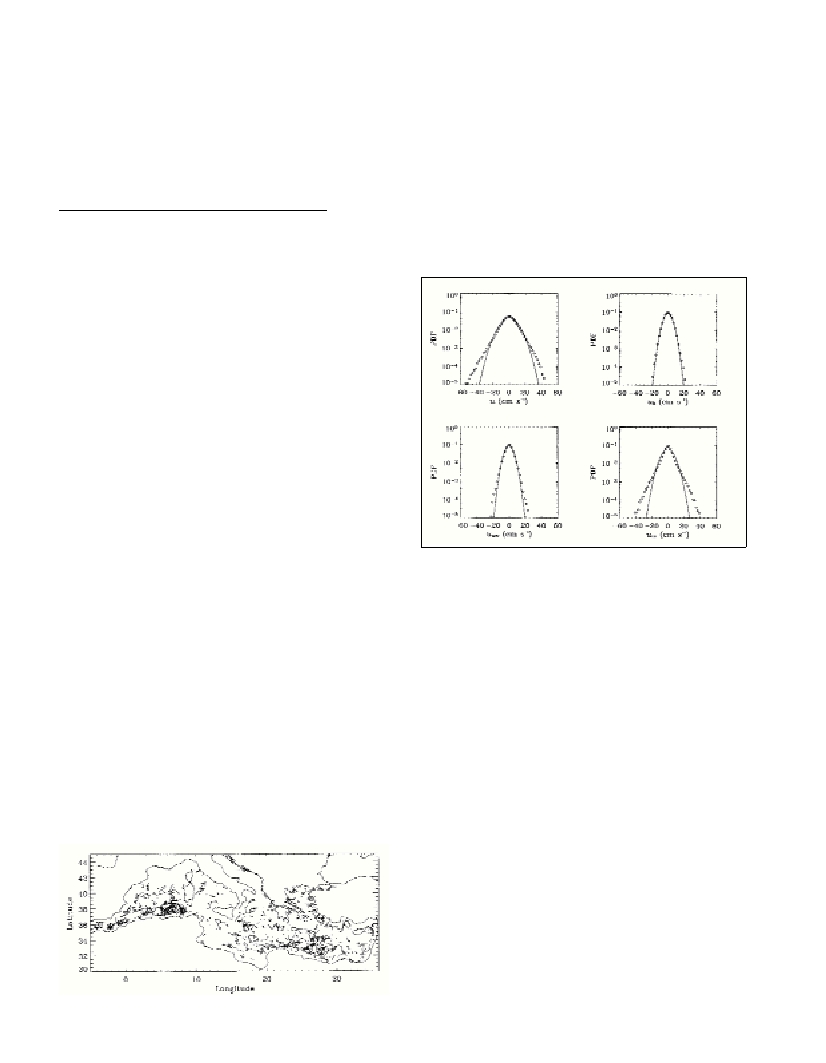Rapp. Comm. int. Mer Médit., 37,2004
107
STATISTICS OF MEDITERRANEAN COHERENT VORTICES:
ANALYSIS OF THE SEA SURFACE HEIGHT
Jordi Isern-Fontanet*, Jordi Font and Emilio García-Ladona
Institut de Ciències del Mar CSIC, Passeig Marítim de la Barceloneta, E-08003 Barcelona, Spain - * jisern@icm.csic.es
Abstract
Basic statistics of coherent vortices in the Mediterranean sea are investigated from the analysis of Sea Level Anomalies. The study includes
the analysis of their energy, amplitude size and spatial distribution. Their effect on velocity Probability Densitiy Function (PDF) is also
analyzed.
Keywords: Mesoscale eddies, velocity PDF, altimetry
Mesoscale variability is characterized by the presence of coherent
vortices. This makes mesoscale observations of ocean resemble two-
dimensional turbulence. This similarity suggests that vortex
identification techniques common in turbulence studies can be used
for ocean studies [1]. The Okubo-Weiss parameter (W) is defined as
the squared strain minus squared vorticity [2,3]. A coherent vortex is
defined as the simply connected region with values of the Okubo-
Weiss parameter W<-0.2
s
where
s
is the spatial standard deviation of
W. When vortices areidentified their properties can be estimated. In
this study, this definition is applied to altimetric Sea Level Anomaly
(SLA) maps between October 1992 and October 1999 constructed by
CLS [4] combining TOPEX/Poseidon and ERS-1/2 data onto a
regular grid [5].
Results show that the Mediterranean sea is characterized by an
approximately homogeneous distribution of vortices. However, some
of their properties such energy or amplitude are irregularly distributed
showing higher values in regions where the presence of mesoscale
eddies is well known. This suggests that a classification based on the
amplitude could allow to separate these eddies from other structures.
The analysis of the dependence of the mean size of vortices with
amplitude shows an asymptotic behavior that tends to radius of the
order of 40 km. These results suggest the heuristic classification of
coherent structures into intense vortices (characterized by values of
the amplitude smaller than -2
s
) that have the size of mesoscale
vortices, and weak vortices (characterized by amplitudes greater or
equal than -2
s
) that correspond to noisy structures and low energy
stages of mesoscale vortices. This separation of structures allows to
easily track vortices from map to map and for the first time construct
a complete picture of the preferential paths followed by them.
Furthermore, the Probability Density Functions (PDF) of the
velocity field derived from SLA maps have also been analyzed. The
Mediterranean sea has been divided into 7 regions depending on the
geometry and the distribution of intense vortices. For each region PDF
of the geostrophic velocities have been calculated. Observed shapes of
velocity PDF are characterized by a Gaussian core with exponential
tails as observed in the Atlantic and numerical simulations of 2D
turbulence [6,7]. However, the size of the core and the tails change
from one region to the other depending on the distribution of intense
vortices. A decomposition of the velocity field into: a background
induced field, a weak vortices-induced field and a intense-vortices
field shows that the first two are characterized by distributions close
to a Gaussian, while the third one has a distribution close to an
exponential distribution.
Acknowledgements :This is a contribution to GRAC project
funded by the Spanish R+D Plan and the European Union (2FD97-
0588) and the IMAGEN project funded by the Spanish R+D Plan
(REN2001-0802-C02-02). Jordi Isern-Fontanet has been partially
supported by contracts from GRAC and IMAGEN projects. Altimetric
maps for the period analyzed were elaborated and provided by CLS
(Toulouse, France) under contract of the MATER project funded by
the European Commission (MAS3-CT96-0051).
Fig. 2. Example of the velocity PDF of the decomposition of the velocity
field (U) into a background-induced field (Ub), a weak eddy-induced field
(Uwv) and an intense eddy induced field (Uiv) for the Algerian basin.
References
1-Isern-Fontanet J., Gacría-Ladona E. and Font J., 2003. Identification of
marine eddies from altimetry. J. Atmos. Oceanic Technol., 20:772-778.
2-Okubo A., 1970. Horizontal dispersion of ?oatable particles in the
vicinity of velocity singularities such as convergences. Deep-sea Res., 17:
445-454.
3-Weiss J., 1991. The dynamics of enstrophy transfer in two-dimensional
hydrodynamics. Physica D,48: 273-294.
4-Le Traon P.Y., Nadal F. and Ducet N., 1998. An improved mapping
method of multi-satellite altimeter data. J. Atmos. Oceanic. Technol.,15:
522-534.
5-Larnicol G., Ayoub N. Le Traon P.Y., 2002. Major changes in the
Mediterranean sea level variability from 7 years of TOPEX/Poseidon and
ERS-1/2 data. J. Mar. Syst.,33-34: 63-69.
6-Bracco A., LaCasce J., Pasquero C. and Provenzale A., 2000. The
velocity distribution of barotropic turbulence. Phys. Fluids,12: 2478-
2488.
7-Bracco A., LaCasce J. and Provenzale A., 2000. Velocity density
functions for oceanic ?oats. J. Phys. Ocean, 30: 461-474.
Fig. 1. Observed trajectories of anticyclonic intense eddies.

